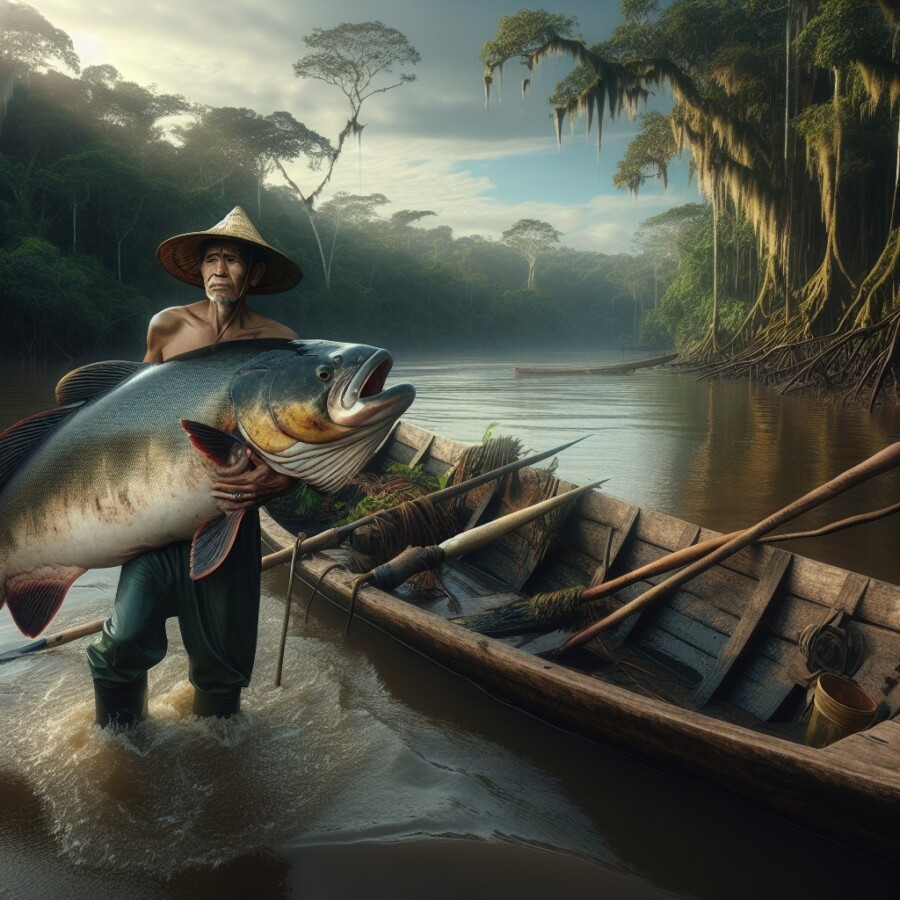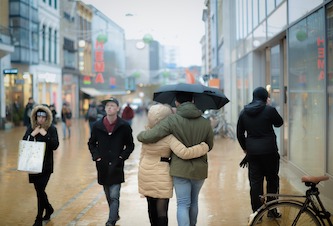Guillermo Otta Parum is a fisherman in the Bolivian Amazon who has been fishing for more than 50 years. He used to catch catfish, but then a huge fish called paiche or Arapaima gigas showed up. At first, Guillermo thought the paiche was dangerous and poisonous, but it’s actually one of the biggest freshwater fish in the world. It can grow up to 4 meters long and weigh over 200kg. The paiche is spreading further into the rivers of the Amazon basin each year, which is a big problem because it’s scaring away other fish and causing them to go to more remote areas.
We don’t know exactly when the paiche arrived in Bolivia, but it’s believed to have come from a paiche fish farm in Peru. Fernando Carvajal, a biologist who knows a lot about paiche, says the fish grows really fast, about 10kg per year when it’s young. Even though it doesn’t have scary teeth, the paiche eats piranhas, other fish, plants, molluscs, and even birds. Fishermen have noticed that there are fewer native fish, and Carvajal says the paiche will keep spreading and hurting the different kinds of fish.
But the arrival of the paiche has actually been good for local fishermen. Even though they were scared of the fish at first, they realized it could be a good thing. People in Bolivia now eat a lot of paiche. Edson Suzano has a place where they process the fish and sell it in supermarkets and markets. The problem for fishermen is finding the paiche in the huge Amazon. The fish likes calm water and moves around when it feels threatened, so fishermen have to go to faraway places in boats and canoes for up to two weeks. This has caused problems with indigenous communities who have rights to the lagoons where paiche live.
The indigenous communities say they are protecting the things they have a right to control, and commercial fishermen often have trouble even if they have the right paperwork. Juan Carlos Ortiz Chávez, a paiche fisherman from an indigenous community, says the younger generation has made rules to stop outsiders from taking their resources. Scientists like Federico Moreno hope that fishing, no matter who does it, will help keep a balance between different kinds of fish and keep the paiche numbers under control.
Original news source: The fish that eats piranhas for breakfast (BBC)
🎧 Listen:
Slow
Normal
Fast
📖 Vocabulary:
| 1 | indigenous | People who are native to a place, having been there for a very long time |
| 2 | biologist | A scientist who studies living organisms and their relationship to their environment |
| 3 | basin | A large natural or artificial depression on the earth’s surface that contains water |
| 4 | molluscs | Soft-bodied animals, usually with a hard shell, like snails and clams |
| 5 | remote | Far away from other places, buildings, or people; isolated |
| 6 | commercial | Related to the buying and selling of goods and services |
| 7 | lagoons | Small bodies of water, often shallow and surrounded by land |
| 8 | resources | Valuable materials or qualities that can be used to meet needs or purposes |
| 9 | threatened | Feeling in danger or under pressure |
| 10 | outsiders | People who are not from a particular place or community |
| 11 | paperwork | Official documents that prove something or give information |
| 12 | generation | All the people born and living at about the same time, regarded collectively |
| 13 | balance | An even distribution of weight or amount that allows something to remain steady or stable |
| 14 | poisonous | Capable of causing illness or death when introduced into the body |
| 15 | supermarkets | Large stores that sell a wide variety of goods including food and household items |
Group or Classroom Activities
Warm-up Activities:
– Vocabulary Pictionary
Instructions: Divide the class into small groups. Give each group a set of vocabulary words related to the article (e.g. paiche, Amazon, fisherman, indigenous, etc.). One member of the group will choose a word and draw it on the board or a piece of paper, while the other group members try to guess the word. The group that guesses the most words correctly wins.
– News Summary
Instructions: Have the students read the article individually or in pairs. Then, ask them to write a brief summary of the main points of the article, focusing on the arrival and impact of the paiche fish in the Bolivian Amazon. Afterward, have a class discussion where students share their summaries and compare their understanding of the article.
– Pros and Cons
Instructions: Divide the class into two groups. Assign one group the task of discussing the pros of the paiche fish’s arrival in Bolivia, and the other group the task of discussing the cons. Give each group time to brainstorm and prepare their arguments. Then, have a debate where each group presents their points. Encourage students to use appropriate language for expressing opinions, agreeing, and disagreeing.
– Opinion Poll
Instructions: Create a set of statements related to the article, such as “The arrival of the paiche fish in Bolivia is a positive thing for local fishermen.” Have the students stand in a line, with one end representing “strongly agree” and the other end representing “strongly disagree.” Read each statement aloud and have students move to the appropriate place on the line to indicate their opinion. After each statement, ask a few students to explain their reasons for their position.
– Future Predictions
Instructions: In small groups, have the students discuss and make predictions about the future impact of the paiche fish in the Bolivian Amazon. For example, they could discuss how the fish might affect the ecosystem, the fishing industry, and the indigenous communities. Each group should present their predictions to the class and explain their reasoning. Encourage them to use future tenses and conditional language to express their ideas.
🤔 Comprehension Questions:
1. Who is Guillermo Otta Parum and what has he been doing for over 50 years?
2. What did Guillermo initially think about the paiche fish? Why did he think that?
3. How big can the paiche fish grow and how much can it weigh?
4. Why is the spreading of the paiche fish a problem in the Amazon basin?
5. Where is it believed that the paiche fish came from and how fast does it grow when it’s young?
6. What does the paiche fish eat and how has this affected the native fish population?
7. How has the arrival of the paiche fish been beneficial for local fishermen in Bolivia?
8. Why do fishermen have difficulties finding the paiche fish and how has this caused problems with indigenous communities?
Go to answers ⇩
🎧✍️ Listen and Fill in the Gaps:
Guillermo Otta Parum is a fisherman in the Bolivian Amazon who has been fishing for more than 50 years. He used to catch catfish, but then a huge fish called paiche or Arapaima gigas (1)______ up. At first, Guillermo thought the paiche was dangerous and poisonous, but it’s actually one of the (2)______ freshwater fish in the world. It can grow up to 4 meters long and weigh over 200kg. The paiche is (3)______ further into the rivers of the Amazon basin each year, which is a big problem because it’s scaring away (4)______ fish and causing them to go to more remote areas.
We don’t know exactly when the paiche arrived in Bolivia, but it’s believed to have come from a paiche fish farm in Peru. Fernando (5)______, a biologist who knows a lot about paiche, says the fish grows really fast, about 10kg per year when it’s young. Even though it doesn’t have (6)______ teeth, the paiche eats piranhas, other fish, plants, molluscs, and even birds. Fishermen have noticed that there are fewer (7)______ fish, and Carvajal says the paiche will keep spreading and hurting the different kinds of fish.
But the (8)______ of the paiche has actually been good for local (9)______. Even though they were scared of the fish at first, they realized it could be a good thing. People in Bolivia now eat a lot of paiche. Edson Suzano has a place where they process the fish and sell it in supermarkets and markets. The problem for fishermen is finding the paiche in the huge (10)______. The fish likes calm water and moves around when it feels threatened, so fishermen have to go to faraway places in (11)______ and canoes for up to two weeks. This has caused problems with (12)______ communities who have (13)______s to the lagoons where paiche live.
The indigenous communities say they are protecting the things they have a right to control, and commercial fishermen often have trouble even if they have the right paperwork. Juan Carlos Ortiz Chávez, a paiche fisherman from an indigenous community, says the younger (14)______ has made rules to stop outsiders from taking their resources. (15)______ like Federico Moreno hope that fishing, no matter who does it, will help keep a (16)______ between different kinds of fish and keep the paiche numbers under control.
Go to answers ⇩
💬 Discussion Questions:
Students can ask a partner these questions, or discuss them as a group.
1. What is the paiche fish and why was Guillermo Otta Parum scared of it at first?
2. How do you think the arrival of the paiche fish has affected the other fish in the Amazon rivers? Why or why not?
3. Do you think it’s a good thing that people in Bolivia now eat a lot of paiche? Why or why not?
4. How do you think the arrival of the paiche fish has affected the local fishermen in Bolivia? Why or why not?
5. How do you think the indigenous communities feel about the presence of commercial fishermen in their lagoons? Why?
6. What do you think about the rules the younger generation of indigenous communities have made to protect their resources? Do you think it’s fair? Why or why not?
7. How would you feel if you had to go on a two-week boat trip to find the paiche fish? Why?
8. Do you think it’s important to keep a balance between different kinds of fish in the Amazon rivers? Why or why not?
9. How do you think the paiche fish has affected the ecosystem of the Amazon basin? Why or why not?
10. What do you think about the idea of fish farming? Do you think it’s a good solution to the decrease in native fish populations? Why or why not?
11. How do you think the paiche fish has impacted the livelihoods of the local fishermen in Bolivia? Why or why not?
12. Do you like eating fish? Why or why not?
13. What do you think about the idea of indigenous communities having rights to control the resources in their lagoons? Do you think it’s fair? Why or why not?
14. How do you think the paiche fish has affected the traditional fishing practices of the indigenous communities? Why or why not?
15. Do you think it’s possible to find a solution that satisfies both the commercial fishermen and the indigenous communities? Why or why not?
Individual Activities
📖💭 Vocabulary Meanings:
Match each word to its meaning.
Words:
1. indigenous
2. biologist
3. basin
4. molluscs
5. remote
6. commercial
7. lagoons
8. resources
9. threatened
10. outsiders
11. paperwork
12. generation
13. balance
14. poisonous
15. supermarkets
Meanings:
(A) Large stores that sell a wide variety of goods including food and household items
(B) People who are not from a particular place or community
(C) Valuable materials or qualities that can be used to meet needs or purposes
(D) Official documents that prove something or give information
(E) Related to the buying and selling of goods and services
(F) A large natural or artificial depression on the earth’s surface that contains water
(G) Feeling in danger or under pressure
(H) All the people born and living at about the same time, regarded collectively
(I) A scientist who studies living organisms and their relationship to their environment
(J) Small bodies of water, often shallow and surrounded by land
(K) Soft-bodied animals, usually with a hard shell, like snails and clams
(L) An even distribution of weight or amount that allows something to remain steady or stable
(M) Capable of causing illness or death when introduced into the body
(N) Far away from other places, buildings, or people; isolated
(O) People who are native to a place, having been there for a very long time
Go to answers ⇩
🔡 Multiple Choice Questions:
1. What is the name of the fish that Guillermo Otta Parum used to catch?
(a) Paiche
(b) Arapaima gigas
(c) Catfish
(d) Piranhas
2. How long can the paiche grow?
(a) Up to 2 meters
(b) Up to 4 meters
(c) Up to 6 meters
(d) Up to 8 meters
3. What is the main problem caused by the spreading of the paiche in the Amazon basin?
(a) It scares away other fish
(b) It attracts more fish
(c) It helps the native fish population
(d) It causes the rivers to flood
4. Where is it believed that the paiche originally came from?
(a) Brazil
(b) Colombia
(c) Peru
(d) Venezuela
5. What does the paiche eat?
(a) Only plants and molluscs
(b) Only other fish
(c) Only piranhas
(d) Piranhas, other fish, plants, molluscs, and even birds
6. How has the arrival of the paiche been beneficial for local fishermen in Bolivia?
(a) They can now catch and sell the paiche
(b) They no longer have to fish for other types of fish
(c) They can now fish in more remote areas
(d) They can now eat the paiche themselves
7. What is the main challenge for fishermen trying to catch the paiche?
(a) Avoiding the dangerous teeth of the paiche
(b) Catching the paiche without scaring it away
(c) Dealing with the aggressive behavior of the paiche
(d) Finding the fish in the huge Amazon
8. Why do indigenous communities have problems with commercial fishermen?
(a) They don’t have the right paperwork
(b) They believe the commercial fishermen are taking their resources
(c) They are not allowed to fish for paiche
(d) They are not skilled enough to catch paiche
Go to answers ⇩
🕵️ True or False Questions:
1. The paiche is not spreading further into the rivers of the Amazon basin each year, scaring away other fish and causing them to go to more remote areas.
2. Guillermo Otta Parum is a fisherman in the Bolivian Amazon who has been fishing for over 50 years.
3. The paiche, also known as Arapaima gigas, is not one of the largest freshwater fish in the world.
4. The paiche is believed to have arrived in Bolivia from a paiche fish farm in Peru.
5. The paiche grows really fast, about 10kg per year when it’s young.
6. The arrival of the paiche has been good for local fishermen in Bolivia, as people now eat a lot of paiche.
7. The paiche cannot grow up to 4 meters long and weigh over 200kg.
8. Even though it does have scary teeth, the paiche does not eat piranhas, other fish, plants, molluscs, and even birds.
Go to answers ⇩
📝 Write a Summary:
Write a summary of this news article in two sentences.
Check your writing now with the best free AI for English writing!
Writing Questions:
Answer the following questions. Write as much as you can for each answer.
Check your answers with our free English writing assistant!
1. What is the name of the fish that has become a problem in the Bolivian Amazon?
2. Why did Guillermo Otta Parum initially think the fish was dangerous and poisonous?
3. How is the paiche affecting other fish in the Amazon basin?
4. Why has the arrival of the paiche been good for local fishermen?
5. What challenges do fishermen face when trying to catch paiche in the Amazon?
✅ Answers
🤔✅ Comprehension Question Answers:
1. Who is Guillermo Otta Parum and what has he been doing for over 50 years?
Guillermo Otta Parum is a fisherman in the Bolivian Amazon who has been fishing for more than 50 years.
2. What did Guillermo initially think about the paiche fish? Why did he think that?
Guillermo initially thought the paiche fish was dangerous and poisonous because he didn’t know much about it.
3. How big can the paiche fish grow and how much can it weigh?
The paiche fish can grow up to 4 meters long and weigh over 200kg.
4. Why is the spreading of the paiche fish a problem in the Amazon basin?
The spreading of the paiche fish is a problem because it is scaring away other fish and causing them to go to more remote areas.
5. Where is it believed that the paiche fish came from and how fast does it grow when it’s young?
It is believed that the paiche fish came from a paiche fish farm in Peru. When it’s young, the paiche fish can grow about 10kg per year.
6. What does the paiche fish eat and how has this affected the native fish population?
The paiche fish eats piranhas, other fish, plants, molluscs, and even birds. This has affected the native fish population because there are now fewer native fish in the rivers.
7. How has the arrival of the paiche fish been beneficial for local fishermen in Bolivia?
The arrival of the paiche fish has been beneficial for local fishermen because people in Bolivia now eat a lot of paiche, so there is a demand for it.
8. Why do fishermen have difficulties finding the paiche fish and how has this caused problems with indigenous communities?
Fishermen have difficulties finding the paiche fish because it likes calm water and moves around when it feels threatened. This has caused problems with indigenous communities because they have rights to the lagoons where the paiche fish live and commercial fishermen often have trouble accessing those areas.
Go back to questions ⇧
🎧✍️✅ Listen and Fill in the Gaps Answers:
(1) showed
(2) biggest
(3) spreading
(4) other
(5) Carvajal
(6) scary
(7) native
(8) arrival
(9) fishermen
(10) Amazon
(11) boats
(12) indigenous
(13) right
(14) generation
(15) Scientists
(16) balance
Go back to questions ⇧
📖💭✅ Vocabulary Meanings Answers:
1. indigenous
Answer: (O) People who are native to a place, having been there for a very long time
2. biologist
Answer: (I) A scientist who studies living organisms and their relationship to their environment
3. basin
Answer: (F) A large natural or artificial depression on the earth’s surface that contains water
4. molluscs
Answer: (K) Soft-bodied animals, usually with a hard shell, like snails and clams
5. remote
Answer: (N) Far away from other places, buildings, or people; isolated
6. commercial
Answer: (E) Related to the buying and selling of goods and services
7. lagoons
Answer: (J) Small bodies of water, often shallow and surrounded by land
8. resources
Answer: (C) Valuable materials or qualities that can be used to meet needs or purposes
9. threatened
Answer: (G) Feeling in danger or under pressure
10. outsiders
Answer: (B) People who are not from a particular place or community
11. paperwork
Answer: (D) Official documents that prove something or give information
12. generation
Answer: (H) All the people born and living at about the same time, regarded collectively
13. balance
Answer: (L) An even distribution of weight or amount that allows something to remain steady or stable
14. poisonous
Answer: (M) Capable of causing illness or death when introduced into the body
15. supermarkets
Answer: (A) Large stores that sell a wide variety of goods including food and household items
Go back to questions ⇧
🔡✅ Multiple Choice Answers:
1. What is the name of the fish that Guillermo Otta Parum used to catch?
Answer: (c) Catfish
2. How long can the paiche grow?
Answer: (b) Up to 4 meters
3. What is the main problem caused by the spreading of the paiche in the Amazon basin?
Answer: (a) It scares away other fish
4. Where is it believed that the paiche originally came from?
Answer: (c) Peru
5. What does the paiche eat?
Answer: (d) Piranhas, other fish, plants, molluscs, and even birds
6. How has the arrival of the paiche been beneficial for local fishermen in Bolivia?
Answer: (a) They can now catch and sell the paiche
7. What is the main challenge for fishermen trying to catch the paiche?
Answer: (d) Finding the fish in the huge Amazon
8. Why do indigenous communities have problems with commercial fishermen?
Answer: (b) They believe the commercial fishermen are taking their resources
Go back to questions ⇧
🕵️✅ True or False Answers:
1. The paiche is not spreading further into the rivers of the Amazon basin each year, scaring away other fish and causing them to go to more remote areas. (Answer: False)
2. Guillermo Otta Parum is a fisherman in the Bolivian Amazon who has been fishing for over 50 years. (Answer: True)
3. The paiche, also known as Arapaima gigas, is not one of the largest freshwater fish in the world. (Answer: False)
4. The paiche is believed to have arrived in Bolivia from a paiche fish farm in Peru. (Answer: True)
5. The paiche grows really fast, about 10kg per year when it’s young. (Answer: True)
6. The arrival of the paiche has been good for local fishermen in Bolivia, as people now eat a lot of paiche. (Answer: True)
7. The paiche cannot grow up to 4 meters long and weigh over 200kg. (Answer: False)
8. Even though it does have scary teeth, the paiche does not eat piranhas, other fish, plants, molluscs, and even birds. (Answer: False)
Go back to questions ⇧













